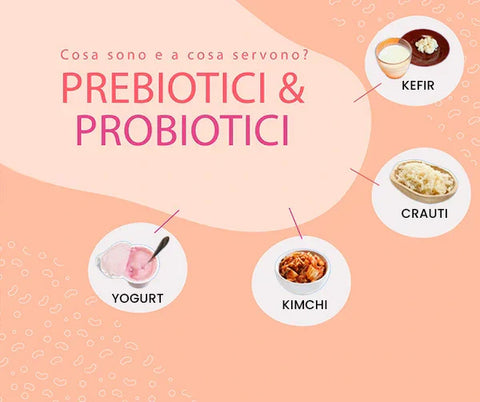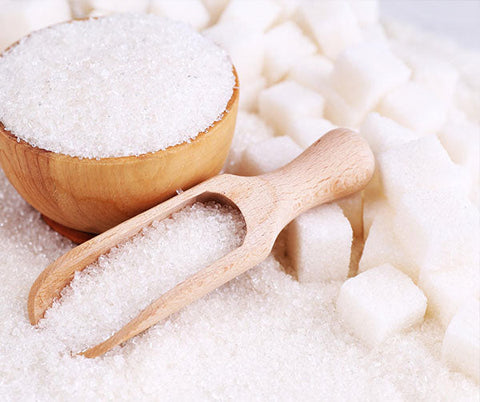Prebiotics and probiotics are two key categories of substances that play a very important role in maintaining the delicate balance of our intestines , promoting gastrointestinal health and contributing to the general well-being of the body.
These compounds, often associated with terms like “fermentable fiber” and “good bacteria,” are the subject of growing scientific interest and are gaining popularity as key elements of a balanced diet.
In this article, we will explore what exactly prebiotics and probiotics are, how they affect our health, and how we can integrate them into our daily diet to improve our well-being.
What are probiotics?
Probiotics are " live microorganisms that, when administered in adequate amounts, confer a health benefit to the host ."
These microorganisms, which are mainly bacteria but also include yeasts, are naturally present in fermented foods, can be added to other food products, and are available as dietary supplements.
Probiotics are identified by their specific strain , which includes the genus, species , subspecies (if applicable), and an alphanumeric strain designation .
The seven major genera of microbial organisms most often used in probiotic products are Lactobacillus , Bifidobacterium , Saccharomyces , Streptococcus , Enterococcus , Escherichia , and Bacillus .
Table 1 shows examples of the nomenclature used for different commercial strains of probiotic organisms.
| Table 1: Nomenclature of commercial probiotic strains | ||||
| Type | Species | Subspecies | Strain designation | Stump nickname |
| Lactobacilli | rhamnose | Nobody | GG | LGG |
| Bifidobacterium | animalis | milk | DN-173 010 | Regular bifid |
| Bifidobacterium | long | long | 35624 | Bifanti |
In which foods are prebiotics found?
Common sources of probiotics include yogurt, cultured buttermilk, and cheese.
Other foods produced through bacterial fermentation include Japanese miso, tempeh, sauerkraut, beer, sour dough, bread, chocolate, kimchi, olives, and pickles.
Another fermented dairy product is kefir.
However, among these, yogurts and fermented milks remain the main food vehicles for probiotics , providing a relatively low pH environment essential for the survival of probiotic bacteria.

Probiotic strains are also found in non-dairy fermented substrates, including soy products, cereals, legumes, cabbage, corn, pearl millet, sorghum, and so on.
Dairy products are the most common and preferred food category among consumers, rich in lactic ferments.
However, dairy products are associated with an increased risk for people with lactose intolerance , galactosemia , milk protein allergy , and high cholesterol levels.
For this reason, the market increasingly requires the use of supplements based on probiotic lactic ferments as a valid alternative.
What are lactic ferments?
“Lactic ferments” and “probiotics” are often confused with each other , even by healthcare professionals.
Lactic ferments or lactic bacteria are bacteria capable of producing lactic acid starting from the fermentation of lactose.
The term therefore refers to a microbial function that microorganisms, even different ones, are able to perform.
The term “lactic ferment” is more famous than “probiotic”; the reason is probably historical, as the use of lactic ferments in ancient times served to preserve milk.
The difference is clear: on the one hand, lactic ferments whose possible effects we cannot be sure of; on the other, probiotics, deposited in databases, of which we know exactly the species, the strain and the molecular detail, with the safety, technological, functional and physiological criteria required by the WHO.
These criteria are necessary for a certain product to be called a probiotic and to be sold as such.
What are probiotics for?
Probiotics are important for improving digestion and absorption of nutrients in our body, because they help break down foreign substances (such as drugs or pollutants) reducing the risk of side effects and are essential for intestinal health.
The microbiota, made up of beneficial bacteria, helps produce important substances such as fatty acids, vitamins and amino acids , contributing to nutritional needs.
Probiotics keep your gut healthy, compete with harmful ones in the intestine , preserving its structural integrity and barrier function.
The gut microbiota also plays a key role in supporting a healthy immune system and interacts with different parts of the body through complex biochemical signals.
This interaction is known as the microbiota-gut-brain axis and the microbiota-gut-lung axis.
Gut bacteria can affect not only the intestines but also anatomical districts such as the brain and lungs.
Changes in the microbiome, caused by chronic stress, medications, or contaminated foods, could alter immune function and balance in the central nervous and respiratory systems.
Read also 👉 What is vitamin D for? What it is, requirements and benefits
What is the difference between probiotics and prebiotics
Prebiotics are not to be confused with probiotics, as they are non-digestible food compounds that selectively promote the growth and activity of beneficial bacteria in the colon.
In other words, they are substances that provide the necessary nourishment for beneficial gut bacteria.
So, probiotics are live microorganisms, prebiotics are substances that promote the growth and activity of beneficial bacteria already present in the intestine.
Often, it is beneficial to consume both in the diet to support a balanced intestinal bacterial flora and promote the health of the organism.
When to take probiotics?
The question of the optimal time to take a probiotic supplement remains a matter of debate, as numerous factors influence the product's effectiveness.
To date, there is insufficient data to define with reasonable certainty the best time to take it.
Most manufacturers rely on a specific study published in 2011 that, through counting, evaluated the impact of the time of administration compared to the meal and the influence of the buffering capacity of the food on the survival of probiotics during gastrointestinal transit.
Counts carried out during and after transit through the gastric and duodenal models showed that the survival of all the bacteria present in the product was better when administered during a meal or 30 minutes before the meal (note that the meal consisted of oatmeal cooked with milk , an uncommon meal in our latitudes).
Probiotics given 30 minutes after this meal showed lower survival.
The presence of fat appears to have some positive impact, as survival in 1% fat milk and oat milk porridge was significantly better than in apple juice or spring water.
The strain Saccharomyces cerevisiae boulardii was not affected by meal time or meal buffering capacity.
Want to know the best time for you to take probiotics?
Access our online nutritional test now to receive specific nutritional advice and a personalized meal plan that will help you live a healthy life. Take control of your life and adopt a proactive approach to health and nutrition.
The best lactic ferments
If you are considering purchasing a probiotic supplement, it is essential to keep in mind that, although they may seem similar, there are often notable differences that affect their effectiveness.
Consider these five helpful parameters before making a decision on which product to choose.
- Number of bacterial species with specific number , a supplement that contains more different species derived from international collections is considered more effective
- Number of live bacteria (CFU) per capsule , efficacy is dose dependent
- The absence of allergens , such as lactose and gluten, makes it suitable for people with allergies or intolerances.
- Absence of additives such as sweeteners or artificial colors, some additives can affect the stability of the bacteria themselves as well as develop adverse reactions.
- Number of live bacteria (CFU) in relation to price

Try PRO-BIO24 now 👇
Particularly relevant, especially in relation to point 5, which considers the number of live bacteria (CFU) in relation to the price , is the incredible difference found between one brand and another.
According to our market analysis, the best-selling probiotic lactic ferment supplements in Switzerland have an average cost per billion bacteria that is almost 100 times higher than that of PRO-BIO24 .

Are probiotics safe?
Probiotics are generally recognized as safe by the U.S. Food and Drug Administration (FDA) or are subject to a Qualified Presumption of Safety (QPS) by the European Food Safety Authority (EFSA).
However, while probiotics are available to healthy consumers in the form of dietary supplements or foods, some patient populations rely on them.
It is important to remember that long-term studies aimed at demonstrating the safety of probiotics in at-risk populations, such as individuals with weakened or compromised immune function, older people, and neonates (especially premature infants), are still limited.
Currently, caution is advised in the use of probiotics in vulnerable populations.
In particular, in the presence of a single major risk factor, such as an immunocompromised state, or more than one minor risk factor, special caution should be exercised in the use of probiotics.
Research continues on this topic to gain a deeper understanding of the safety of probiotics, especially in specific clinical settings.
Sources:
- Cells. 2023 Jan; 12(1): 184.doi: 10.3390/cells12010184 , Probiotics Mechanism of Action on Immune Cells and Beneficial Effects on Human Health
- Gut Microbes. 2023; 15(1): 2185034. doi: 10.1080/19490976.2023.2185034 , Emerging issues in probiotic safety: 2023 perspectivesNutrients doi: 10.3390/nu14235155. Microbiome Therapeutics for Food Allergy


